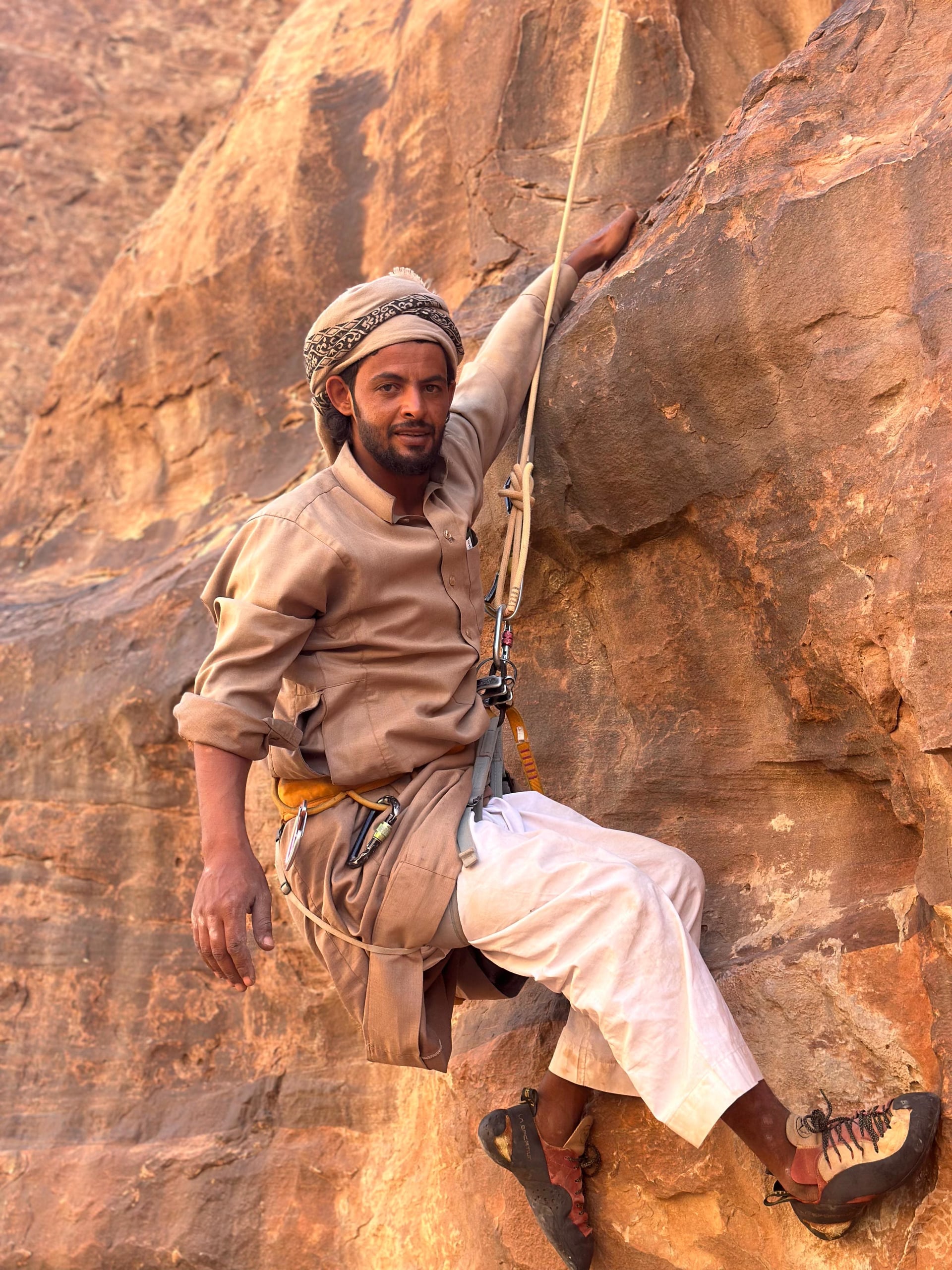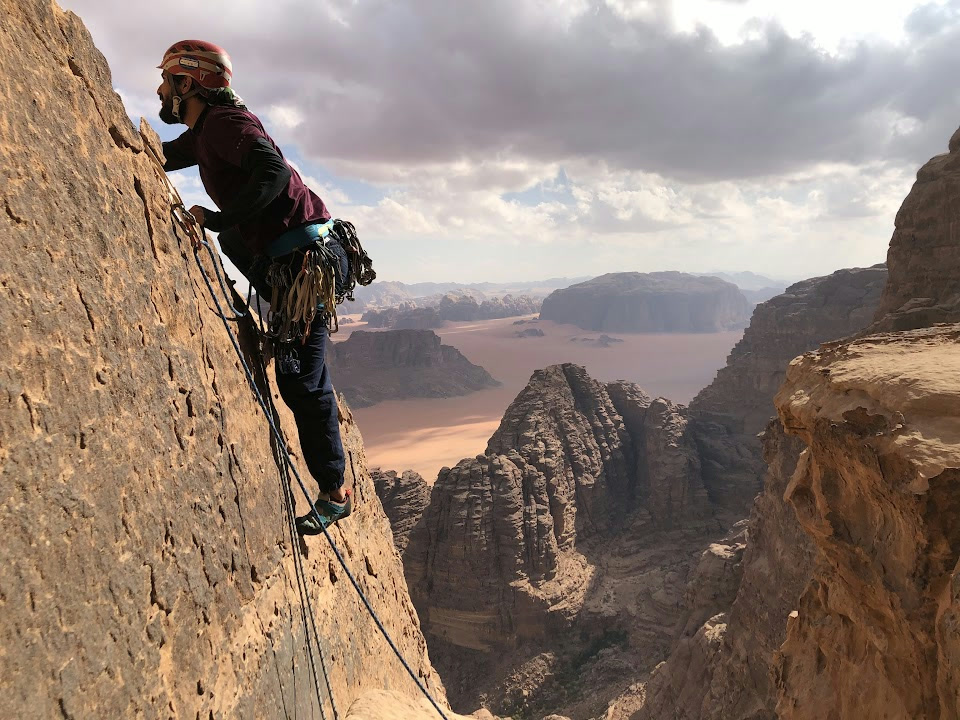If you're used to climbing at sport crags or even traditional routes in other areas, Wadi Rum will challenge your understanding of what climbing grades mean. Here, a Grade 5 route can be more serious and committing than a Grade 7 elsewhere. Let me explain why.
The Bedouin Definition of Difficulty
For centuries, my Bedouin ancestors climbed these mountains for survival-hunting ibex, gathering water and medicinal herbs, accessing remote areas. These ascents were usually undertaken alone and often barefoot, with no safety equipment whatsoever. An error would often prove fatal.
When Tony Howard's 1984 exploratory team arrived, they were astonished to find that the Zalabia Bedouin knew their mountains intimately and climbed extremely long, complex hunting routes-sometimes requiring moves equivalent to Grade 5 (Very Severe in UK grading) or even harder, all without any protection.
The Key Insight: The routes climbed by the Bedouin, often graded up to Grade 5, are "atypical" because the grade reflects the inherent danger of unprotected movement across vast, convoluted terrain, rather than sustained, gym-like technical difficulty.
What Makes a Route "Difficult" Here
1. Length and Commitment
A Grade 5 section might be brief-maybe just a few moves. But the overall commitment is what matters. We're talking about 500 meters or more of vertical gain, often taking 6-10 hours, with complex route-finding through a maze of domes and canyons.
The difficulty is a measure of survival necessity combined with technical execution. It places greater emphasis on the climber's intuition and holistic mountain sense than on isolated physical strength.
2. Navigational Complexity
On Jebel Rum, summit routes are measured in **kilometers** for a modest altitude gain of only 700-800 meters. Why? Because the massif is "slashed by barrier walls and ravines" that run the full width of the plateau. These are vertical walls, sometimes hundreds of meters deep, often only crossable at one specific, hard-to-find point.
Traditional alpine strategy, which prioritizes vertical gain, is useless here. The critical skill is geometric route visualization across the dome landscape.
Source: American Alpine Club Journal
3. Unavoidable Exposure
Unlike a sport climb where you might have sustained difficulty for 30 meters, Wadi Rum routes involve unavoidable exposure over hundreds of meters. You're committed. There's no quick escape, no easy bail-out. Once you start, you need to finish.
Real Examples
The Bedouin Hunter's Perspective
Imagine climbing a 500-meter route, alone, barefoot, with a rifle on your back. The technical crux might only be Grade 5, but:
- • You have zero protection
- • The route winds through complex terrain requiring constant decision-making
- • You need to remember the way for the descent
- • If you're successful, you're climbing back down with an ibex on your back
- • A single mistake means death
This is why these routes represent "a form of domain expertise that many of today's technical climbers would find extraordinarily difficult to match."
Source: Engaging Cultures - Tony Howard Interview
Modern Climbing Example
When Tony Howard's team first attempted Jebel Rum in 1984, they thought a route would take 4 hours. It required **two unplanned bivouacs** due to unexpected length and complex route-finding. These were experienced mountaineers, but the maze-like terrain defeated their expectations.
Source: American Alpine Club Journal
The Modern Reality
Today's climbers have ropes, cams, and modern equipment. But the fundamental challenge remains: Wadi Rum climbs are typically long, serious, and require comfort with traditional climbing methods and extensive self-reliance.
The character of climbing adventure here is defined not merely by the difficulty grade of the moves, but by:
- • The seriousness of the commitment
- • The complexity of navigational challenges
- • The deep immersion in unique cultural history
Source: ResearchGate - New Heights in Climbing and Tourism
Understanding the True Challenge
When you climb with me in Wadi Rum, I'll help you understand that the number on the route is just one small part of the story. The real challenge-and the real reward-comes from engaging with the mountain on its own terms, respecting the commitment it demands, and connecting with the ancient tradition of climbing these peaks.
Book a Guided ClimbWhat This Means for You
If you're planning to climb in Wadi Rum:
- • Don't judge routes by grade alone-read about the commitment level
- • Expect routes to take longer than you think
- • Prepare for complex navigation and potential bivouacs
- • Hire a local guide who knows the terrain intimately
- • Approach even "moderate" grades with respect and preparation
In Wadi Rum, climbing grade is secondary to commitment. The crucial challenge is not physical difficulty but holistic mountain mastery-navigation, resource management, and reliance on deep geographical knowledge. This is what makes our mountains special, and what makes every ascent a true adventure.
Sources:
- • Wadi Rum Trail - Classic Bedouin Climbs
- • Engaging Cultures - Tony Howard Interview
- • American Alpine Club Journal - Wadi Rum Exploration
- • ResearchGate - New Heights in Climbing and Tourism
- • Research report: "Wadi Rum: Sandstone Labyrinths, Bedouin Lines, and the Pursuit of Atypical Adventure"


💬 Join the Discussion
Share your thoughts, experiences, or questions about this article